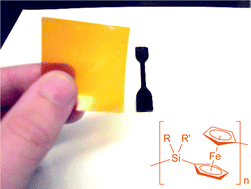Polyferrocenylsilanes: synthesis, properties, and applications
Abstract
This in-depth review covers progress in the area of polyferrocenylsilanes (PFS), a well-established, readily accessible class of main chain organosilicon metallopolymer consisting of alternating ferrocene and organosilane units. Soluble, high molar mass samples of these materials were first prepared in the early 1990s by ring-opening polymerisation (ROP) of silicon-bridged [1]ferrocenophanes (sila[1]ferrocenophanes). Thermal, transition metal-catalysed, and also two different living anionic ROP methodologies have been developed: the latter permit access to controlled polymer architectures, such as monodisperse PFS homopolymers and block copolymers. Depending on the substituents, PFS homopolymers can be amorphous or crystalline, and soluble in organic solvents or aqueous media. PFS materials have attracted widespread attention as high refractive index materials, electroactuated redox-active gels, fibres, films, and nanoporous membranes, as precursors to nanostructured magnetic ceramics, and as etch resists to plasmas and other radiation. PFS block copolymers form phase-separated iron-rich, redox-active and preceramic nanodomains in the solid state with applications in nanolithography, nanotemplating, and nanocatalysis. In selective solvents functional micelles with core–shell structures are formed. Block copolymers with a crystallisable PFS core-forming block were the first to be found to undergo “living crystallisation-driven self-assembly” in solution, a controlled method of assembling block copolymers into 1D or 2D structures that resembles a living covalent polymerisation, but on a longer length scale of 10 nm–10 μm.

- This article is part of the themed collections: Celebrating the 2017 RSC Prize and Award Winners and Smart Inorganic Polymers

 Please wait while we load your content...
Please wait while we load your content...